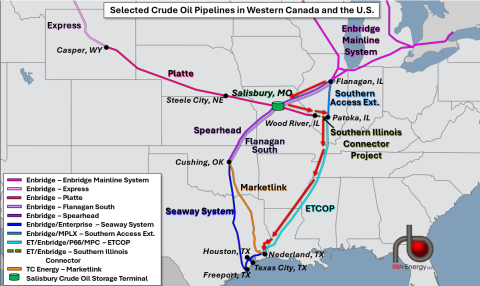A few months ago, Enbridge unveiled its plans to expand its massive Mainline and smaller Express/Platte crude oil pipeline systems into the U.S. Midwest/Great Plains. We blogged about those plans, and followed up with a look at how the incremental volumes of Western Canadian crude on the Mainline and Express/Platte might move south from PADD 2 to where they’re wanted most: the Gulf Coast. In today’s RBN blog, we discuss efforts to piece together a more direct pipeline route from Alberta to Cushing and on to the Texas/Louisiana coast.
Two of the surest bets in the North American energy space these days are that (1) Western Canadian production of heavy crude oil will continue rising and (2) new pipeline takeaway capacity will be needed — sooner or later — to handle those increasing volumes. In Here, There and Everywhere, we discussed Enbridge’s plan to spend up to C$2 billion (US$1.5 billion) by 2028 to improve the efficiency and reliability of its 3.28-MMb/d Mainline pipeline system from Alberta to the Midwest. We noted that Enbridge is investing another C$1.5 billion (US$1.1 billion) by 2027 on a multiphase optimization project that will boost the system’s capacity by 150 Mb/d — and maybe more, if demand warrants. In addition, the company is looking to add up to 30 Mb/d of capacity to its 310-Mb/d Express-Platte pipeline system, which runs from Hardisty, AB, to Wood River, IL, just west of the Patoka, IL, crude oil hub.
More recently, in Take the Long Way Home, we looked at where those incremental barrels being piped south to PADD 2 (Midwest/Great Plains) would end up and, just as important, how they would get there. As we explained, most of those barrels will be heavy crude from the Alberta oil sands and, given that PADD 2 refineries can’t shoehorn much more low-API oil into their crude slates, almost all of the incremental imports will need to flow through the Midwest to the Cushing, OK, hub and on to refineries and export terminals along the Gulf Coast.
Figure 1. Selected Crude Oil Pipelines in Western Canada and the U.S. Source: RBN
We noted a few possibilities for enhancing the pipeline infrastructure south of the Mainline and Express/Platte systems, including a 100-Mb/d expansion of Enbridge’s 700-Mb/d Flanagan South Pipeline (light-purple line in Figure 1) from the Mainline’s Flanagan, IL, hub to Cushing.
Join Backstage Pass to Read Full Article









